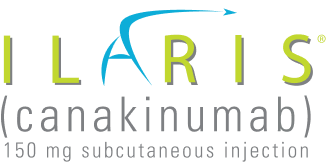
Safety
Not an actual patient. Individual results will vary.
Still’s Disease
Consistent safety profile of ILARIS in patients aged 2 years and older1
| Pivotal Studies | SJIA Study 1 | |
| ILARIS (n=43) | Placebo (n=41) | |
| All infections* | 30% | 12% |
| Exposure-adjusted incidence rate per 100 patient-days | 1.26 | 1.37 |
| Abdominal pain (upper) | 7% | 2% |
| Exposure-adjusted incidence rate per 100 patient-days | 0.25 | 0.23 |
| Mild injection site reactions | 0% | 7% |
| Moderate injection site reaction | 0% | 0% |
| Pivotal Studies | SJIA Study 2 | ||
| Corticosteroid-tapering phase | ILARIS withdrawal phase | ||
| ILARIS (n=177) | ILARIS (n=50) | Placebo (n=50) | |
| All infections* | 55% | 54% | 38% |
| Exposure-adjusted incidence rate per 100 patient-days | 0.91 | 0.59 | 0.63 |
| Abdominal pain (upper) | 14% | 16% | 12% |
| Exposure-adjusted incidence rate per 100 patient-days | 0.16 | 0.15 | 0.08 |
| Mild injection site reactions | 11% | 12% | 4% |
| Moderate injection site reaction | 1% | 2% | 0% |
*The most commonly reported infections were nasopharyngitis and (viral) upper respiratory tract infection. Other infections included pneumonia, rhinitis, pharyngitis, tonsillitis, sinusitis, urinary tract infection, gastroenteritis, and viral infections.1
ILARIS did not appear to increase the incidence of MAS1
Eleven cases of MAS were observed in 201 patients with SJIA treated with ILARIS in clinical trials. Based on the clinical trial experience, ILARIS does not appear to increase the incidence of MAS in patients with Still’s disease, but no definitive conclusions can be made.
MAS is a known life-threatening disorder that may develop in patients with rheumatic conditions, in particular Still’s disease, and should be aggressively treated.
Additional safety information
- ILARIS has been associated with an increased risk of serious infections. Infections, predominantly of the upper respiratory tract, in some instances serious, have been reported with ILARIS1
- Generally, the observed infections in ILARIS clinical trials responded to standard therapy. Isolated cases of unusual or opportunistic infections (eg, aspergillosis, atypical mycobacterial infections, cytomegalovirus, herpes zoster) were reported during ILARIS treatment. A causal relationship of ILARIS to these events cannot be excluded1
- Serious infections (eg, pneumonia, varicella, gastroenteritis, measles, sepsis, otitis media, sinusitis, adenovirus, lymph node abscess, pharyngitis) were observed in approximately 4% to 5% (0.02 to 0.17 per 100 patient-days) of patients receiving ILARIS in pivotal studies1
- No injection site reactions led to study discontinuation1
- No anaphylactic reactions attributable to treatment with canakinumab were reported1
The safety profile of ILARIS in AOSD patients in a randomized, double-blind, placebo-controlled study in 36 adult patients (aged 22 to 70 years) was similar to what was observed in SJIA patients.1
Reference: 1. Ilaris. Prescribing information. Novartis Pharmaceuticals Corp.
